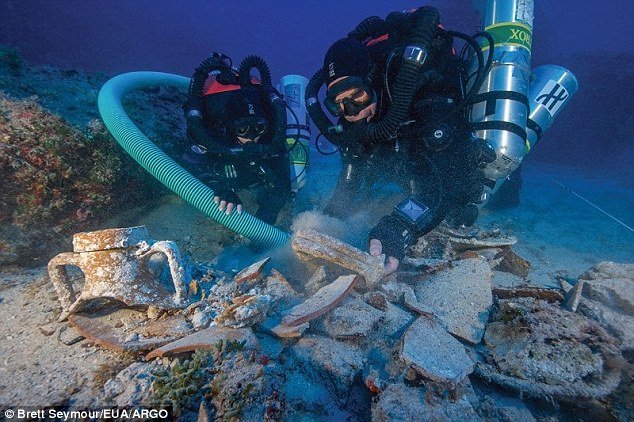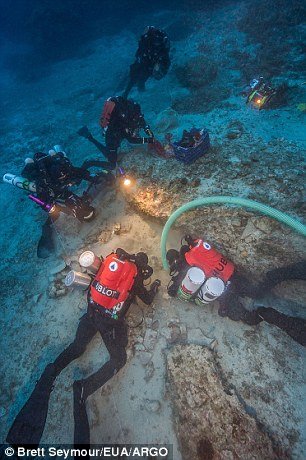MessageToEagle.com – Underwater archaeologists have returned to the ancient shipwreck of Antikythera to learn more about its luxurious and extravagant artefacts.
During the latest dive experts spent a total of 40 hours on the sea bed to unearth more than 50 new treasures.
These include the remains of a bone flute, a pawn from an ancient board game, fine glassware and a bronze armrest believed to have been part of a throne.
The shipwreck dates to circa 65 BC and was discovered by Greek fishermen in 1900 off the southwestern Aegean island of Antikythera.
A year later, four giant marble horses were discovered on the wreck by sponge divers and it is thought these formed part of a complex of statues involving a warrior in a chariot that was pulled by the horses.
In total, divers salvaged 36 marble statues of mythological heroes and gods, a life-sized bronze statue of an athlete, scores of luxury items and the skeletal remains of crew and passengers.
They also found fragments of the world’s first computer called the Antikythera Mechanism – a geared mechanical device that encoded the movements of the planets and stars, and predicted eclipses.
The highly complex mechanism, consisting of up to 40 bronze cogs and gears, was used by the ancient Greeks to track the cycles of the solar system.
It was so advanced, it took another 1,500 years for an astrological clock of similar sophistication to be made in Europe.
Last year, the Woods Hole Oceanographic Institution (WHOI) launched a long-term research program at the site with the Hellenic Ministry of Culture and Sports to excavate the wreck.
At the time, the researchers created a high-resolution, 3D map of the site using stereo cameras mounted on an autonomous underwater vehicle (AUV).
This map covers a staggering 113,020 square feet (10,500 square metres) of sea floor.
Hampered by bad weather, the original expedition included just four dive days for technical divers who recovered a series of finds on the surface and proved that much of the ship’s cargo is still preserved beneath it.
By contrast, this year’s expedition included 40 hours of diving time and the divers were joined by four professional archaeologists for the first time.
They performed controlled excavation to the highest scientific standard using the multi-dimensional map for guidance, at depths of 180ft (55-metre).
It was the first scientific excavation of the wreck and launched the first comprehensive study of all of its artefacts.
During the multi-year program the team expects to recover artefacts and ancient artwork still buried in the seafloor, and recreate the history of the ship’s cargo and its final voyage.
‘This shipwreck is far from exhausted,’ said project co-director Dr. Brendan Foley, a marine archaeologist with WHOI.
‘Every single dive on it delivers fabulous finds, and reveals how the “1 per cent” lived in the time of Caesar.’
In addition to Dr Foley, the 2015 exploration at Antikythera was conducted by the Greek Ephorate of Underwater Antiquities under director Dr. Ageliki Simosi and field archaeologists Dr. Theotokis Theodoulou and Dr. Dimitris Kourkoumelis.
The ten-man dive team used advanced technical diving equipment including closed-circuit rebreathers and trimix breathing gases, performing 61 dives in 10 days of diving on the wreck.
A remotely operated vehicle monitored and recorded all diving activities, and served as a communications link between divers and support personnel on the surface.
Meanwhile, a metal detection survey of the site revealed that metallic targets are dispersed over an area of around 130 feet by 165 feet (40 x 50 metres).
This is thought to match the wreck’s debris field, indicating the size of the ship that sank off the cliffs of Antikythera. In particular, the dive team recovered items including an intact amphora, a large lead salvage ring, two lead anchor stocks – possibly indicating the ship’s bow – and fragments of a lead hull sheathing.
A small and finely-formed lagynos, or table jug, and a chiseled stone object perforated by 12 holes and filled with an as-yet-unidentified substance were also found.
The 50 new artefacts were excavated from a series of nine trenches in the seabed using a water dredge powered by a submersible pump.
‘We were very lucky this year, as we excavated many finds within their context, which gave us the opportunity to take full advantage of all the archaeological information they could provide,’ said Dr Theodoulou.
The team has since created 3D virtual reconstructions of many artefacts on the seafloor, and 3D-modelled all of the major recovered artifacts once on shore.
A series of scientific analyses are now being conducted on these artefacts, including ancient DNA analysis of ceramic jars to identify the 2,000 year-old food, drinks, perfumes, and medicines contained in them.
Isotopic analysis of lead objects will additionally determine where the lead was mined, to reveal the home port of the ship.
Previously recovered artifacts from the Antikythera Shipwreck are on display in a special exhibition ‘Der Versunkene Schatz das Schiffswrack von Antikythera’ [The Sunken Treasure of the Antikythera Shipwreck] at the Basel Antiquities Museum in Switzerland.
The exhibition runs until March and it is the first time that these ancient treasures have been allowed to leave the National Archaeological Museum in Athens.
MessageToEagle.com via Daily Mail








